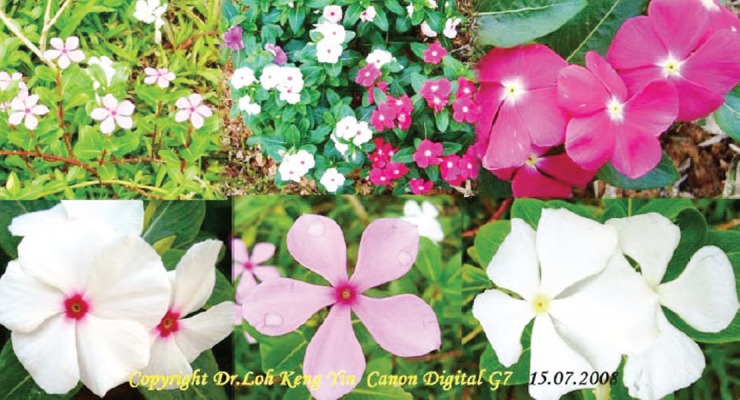
| Kingdom: | Plantae |
| Division: | Magnoliophyta |
| Class: | Magnoliopsida |
| Order: | Gentianales |
| Family: | Apocynaceae |
| Genus: | Catharanthus |
| Species: | C. roseus |
Catharanthus roseus (synonymous with Vinca rosea) is a perennial plant commonly seen in tropical countries. Seven species of this genus are native to Madagascar and one species is native to Southern Asia.1 It is more commonly known as Madagascar periwinkle. The local name in Malaysia is Kemunting Cina. The National Cancer Council of Malaysia (Majlis Kanser Nasional, MAKNA) uses the periwinkle logo as its symbol of hope for cancer patients.2
This plant produces beautiful flowers with a variety of colours such as purple, pink and white and commonly planted for decorative purposes. Historically Madagascar periwinkle had been used for various treatments, e.g. diabetes mellitus, high blood pressure and infection.3
The stem of Madagascar periwinkle produced a milky sap which is the source of over 70 different indole alkaloids. Two of the common anti-cancer drugs which are derived from this plant are vincristine and vinblastine (they are named after Vinca).4 Vincristine is used in the chemotherapeutic regime for Hodgkin’s lymphoma while vinblastine is used for childhood leukemia. These vinca alkaloid bind to tubulin dimers and inhibiting microtubule structures of the cells, thus inhibiting the metaphase of cellular mitosis. Their Main side effects of these drugs are peripheral neuropathy, hair loss, hyponatremia and constipation.5
References
- 1.Catharanthus Wikipedia Online Free Encyclopedia. http://en.wikipedia.org/wiki/Vinca_alkaloids#vinca_alkaloids(accessed 20 July 2008)
- 2. Periwinkle: About MAKNA. http://www.makna.org.my/periwinkle.asp(accessed 20 July 2008)
- 3.Catharantus Flora of China. http://www.efloras.org/florataxon.aspx?flora_id=12&taxon_id=105876(accessed 20 July 2008)
- 4.Catharantus Roseus – periwinkle. Tropiclab Inc. www.tropilab.com/periwinkle.html(accessed 20 July 2008)
- 5.Johnson IS, Armstrong JG, Gorman M, Burnett JP. The vinca alkaloids: a new class of oncolytic agents. Cancer Res. 1963;23:1390–427. [PubMed] [Google Scholar]


